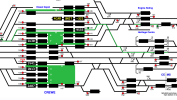I'm thinking, but very much open to correction, that both CE154-CE148 (the route from the up Manchester line to platform 6 or the up fast) as well as CE154-CE150 (the route to platforms 5 and 1) have conditional double reds, meaning that if the second signal is red then the CE154 also needs to be red until some condition is satisfied.
The previous problem with TACL has been removed (
https://www.railforums.co.uk/threads/approach-control-signalling-at-crewe.212702/), so if either CE148 or CE150 are clear then CE154 will also be clear, so I think this conditional double red only applies to slow down trains when the route isn't clear. And having the up Cardiff use platform 5 rather than platform 6 makes this less likely, because the route no longer has to cross the up and down fast lines to get into the platform, and so the double red is less likely.
But, as I say, some of this is guesswork and I'd be very happy to be corrected.
I have attached a diagram from Open Train Times (
https://www.opentraintimes.com/maps/signalling/crewe) to help provide context to those unfamiliar with Crewe. By coincidence it shows 1V41 (11:30 Manchester Piccadilly to Carmarthen) ready to depart from platform 5. In the recent past this train would have used platform 6.
View attachment 152004
PS The conditional double red may only apply to the CE154-CE148 combination, but this doesn't alter the argument because this is the combination which used to apply to the Manchester-Cardiff trains going into platform 6.
From
https://www.railsigns.uk/info/tpws1.html:
Standard TPWS, with OSS loops placed no more than 450 metres from the signal as described earlier, is generally capable of stopping a train travelling at up to 75 mph inside the safe overrun distance. By installing an extra OSS at a greater distance from the signal, the effectiveness of TPWS for higher-speed applications can be increased. This type of fitment was originally called 'TPWS+', and the additional OSS was termed an OSS+. The OSS+ trigger loop was normally placed 750 metres from the signal, with the arming loop originally placed a further 28.3 metres in rear, resulting in a set speed of 65 mph for passenger trains. The maximum distance for an OSS+ was later increased to 900 metres. The OSS+ can stop a train approaching at the maximum permissible speed, leaving the standard OSS only having to deal with trains approaching at a speed below the set speed of the OSS+. The terms TPWS+ and OSS+ are no longer used for new fitments requiring an OSS further than 450 metres from the signal.
Where TPWS+ would not give the desired protection, 'TPWS OS' (Outer Signal) may be fitted. With TPWS OS, no OSS+ is provided, but the next signal in rear is fitted with TPWS. When the junction protecting signal is at 'danger' and no forward route is set, the signal in rear will be held at red until the train has passed its OSS. This control is called '
conditional double red'. The outer signal's OSS was usually positioned at the maximum distance that was possible with standard TPWS (450 metres), to minimise delay to trains. The arming loop was 23 metres from the trigger loop, giving a set speed of 53 mph for passenger trains. A train travelling below that speed can be stopped inside the safe overrun distance by the TPWS fitted at the signal ahead.


